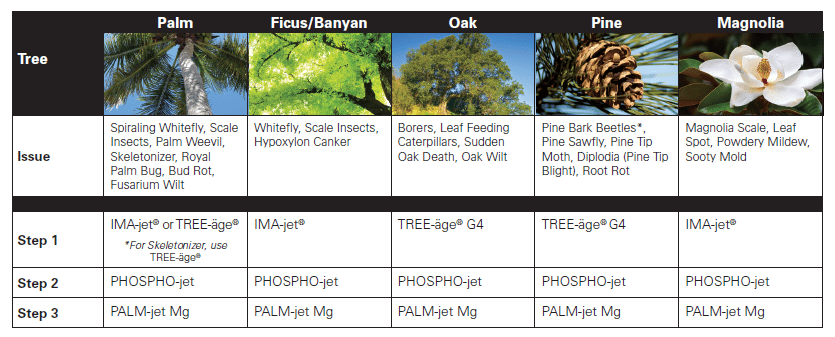Hurricane Irma’s impact on much of Florida, was catastrophic – the most intense in the Atlantic since Dean in 2007. Like many other storms, Irma caused widespread damage to landscapes, including trees, palms, and plant material, throughout both Florida and the southeast. Numerous trees were lost, while many of those remaining were left severely damaged and may need help to survive and thrive.
We must act quickly to help the trees damaged by Hurricane Irma, and also to assure that they are healthy before the next weather event. The sooner we act, the better the chance we have to aid in their recovery, prevent further decline, and reduce the risk of insect attacks on weakened trees and palms.
The Various Impacts of Adverse Weather on Trees
Trees, palms, and shrubs are affected by hurricanes in several ways. Salt damage to roots and leaves, wind damage to trunks and branches, submersion of roots by flooding, and loss of leaf tissue are the most common ailments you’ll see after a catastrophic storm.
Salt damage from flooding and ocean water carried on the wind can infiltrate the soil and affect tree nutrition and water absorption. Salt displaces the nutrients trees need to survive, and excessive salt causes soil aggregates to break down, affecting aeration and water uptake. Salt in the soil will actually pull moisture out of the roots, causing root desiccation. Salt can also scorch or burn leaves, causing premature defoliation and a reduction in new growth for several years.
Strong winds damage tree trunks and branches, causing visible damage, and increasing tree instability. This damage also makes it difficult for trees to absorb nutrients and water, impacting vascular tissue while making them susceptible to boring pests.
When trees’ leaves are lost, they also lose the ability for adequate photosynthesis. This means the tree is unable to create the energy necessary to sustain tree health. This further weakens the tree and makes it less capable of surviving through stressful periods like other storms, excessive heat, prolonged drought, or high winds.
What to Do About Damaged Trees
Damaged trees should be inspected by a certified arborist to determine the extent of damage. Tree and palm survival can be greatly encouraged through a combination of cultural practices (pruning, staking, mulching, watering, etc.) and applications of nutrients, and disease and insect control products to help improve the plants’ overall health and vigor while protecting them from current and future pests or environmental stressors.
3-Step Plant Healthcare Program
After a hurricane passes, water generously to flush marine salts from the soil. Then, we recommend you help strengthen your palm and trees’ natural defenses and protect them against attack using our 3-Step Plant Healthcare (PHC) Program.
We also suggest using soil amendments and growth regulators to stimulate root activity, repair damage, increase root recovery, and enhance the soil microbial environment. This will encourage new root development after the salt damage. Water management solutions may also be helpful in enhancing root growth, improving water retention, and giving trees a chance to rebound and recover while creating new leaf tissue. We’ll get into a few recommended options below.

Each of these products are essential in aiding plant recovery and/or root enhancement. Results may vary based on the severity of plant damage, current plant health, soil conditions, and weather conditions.
We recommend the following:
Plant Recovery:
PALM-jet Mg
- Nutrient package formulated to improve overall plant health and vigor
- Trunk injection for quick uptake of nutrients
- Long residual (full season in many cases)
- Low doses with effective results
PHOSPHO-jet
- Plant resistance activator (stimulates plants’ own defense system)
- Strengthens cell walls (aids in plant recovery)
- Works as a fungicide, plant health elicitor, and degrades into plant nutritional components
IMA-jet®
- Season-long control of many insect pests, including White Fly, Royal Palm Bug, Weevils (including Palm), Mealybug, Soft Scales, Leaf Hoppers, Leaf Miners, Buprestid Borers, Longhorn Beetle, and many more
TREE- äge® G4
- Injected insecticide for two-year control of insect and mite pests, including Pine Bark Beetle, Ambrosia Beetle, Leaf Feeding Caterpillars, Gall Wasp (various), Borers (various), Conifer Mites, and many others in deciduous, coniferous, and palm trees
Root Enhancement:
NutriRoot® (soil applied)
- Supplies organic matter and aids in the proliferation of soil microorganisms
- Reduces water run-off from repellent, dry soil surfaces
- Can be used throughout the entire growing season
- Aids in transplant success
- Reduces watering frequency and plant loss
- Increases root development
- Supplemental micro and macro nutrients
Shortstop® 2SC (basal drench)
- Assists in internal water management under high salt soil conditions
- Increases fine root mass after root loss from weather events or soil erosion
- Encourages thicker foliage more resistant to pest pressure
- Reduces pruning, enhances chlorophyll production resulting in greener plants

It’s Time to Act
Putting a protection plan in place ahead of time or acting quickly to save trees after a storm offers the best chance at saving the landscape. Though Hurricane Irma caused massive destruction in the southeast, you may still be able to minimize prolonged plant decline. We recommend starting the recovery process now to protect against Pine Beetles, whose populations will explode in response to the hurricane’s damage, while the trees defensive systems are suppressed. Together, we can make sure this doesn’t happen.
Connect with Arborjet today to start the conversation. We have a Regional Technical Manager in your area to recommend personalized options for any landscape, in any weather condition.
To learn more about hurricane recovery for trees and palms and about our 3-Step PHC Program, download and share our informational handout.
